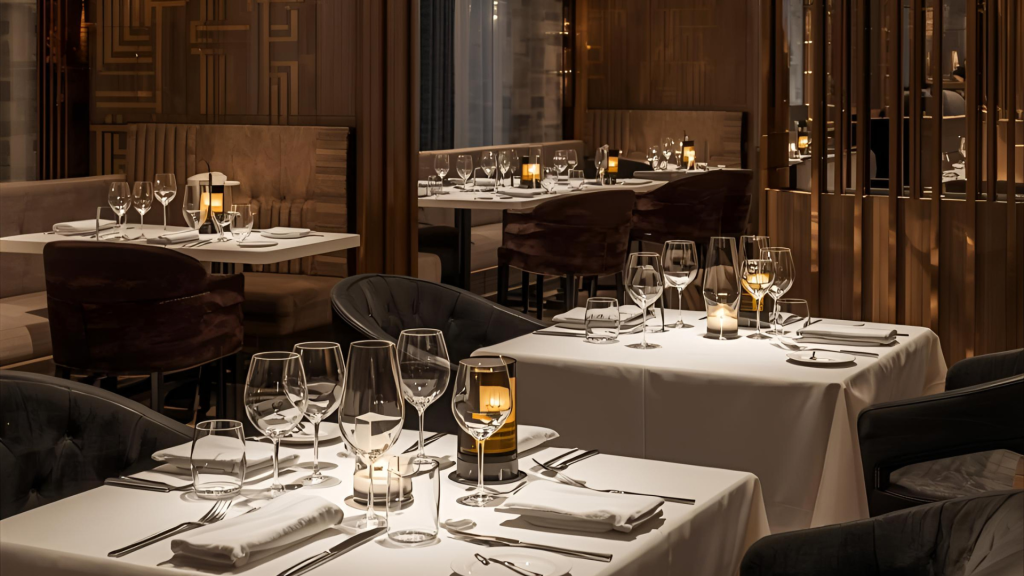In the fast-paced, ever-evolving culinary landscape of Singapore, staying ahead of the curve is paramount. As we look towards 2025, the role of restaurant interior design has transcended mere aesthetics. It has become a critical business strategy, a tool for storytelling, and the primary driver of the all-important dining experience.
The era of simply being “Instagrammable” is maturing. While a visually appealing space is still essential, diners are now seeking deeper connections, authenticity, and a sense of purpose from their chosen establishments. The top restaurant interior design trends for 2025 reflect this shift, focusing on creating multi-sensory, meaningful, and highly functional environments.
Here are the five key trends that will define the next wave of successful F&B spaces in Singapore.
1. Conscious Dining by Design: The Rise of Hyper-Sustainability
Sustainability is no longer a buzzword; it’s a core brand value that discerning diners actively seek out. In 2025, this goes far beyond simply avoiding plastic straws. “Hyper-sustainability” means the design itself is a testament to your restaurant’s eco-conscious ethos.
- What it is: A design philosophy that prioritizes recycled, upcycled, and locally sourced materials. It’s about transparency in your design choices, just as you have in your food sourcing.
- Why it’s trending: Modern consumers are increasingly eco-aware and align their spending with their values. A visibly sustainable interior builds brand trust and resonates with a powerful and growing market segment.
- How to implement it:
- Materials: Think terrazzo made from recycled marble chips, tabletops crafted from reclaimed local timber, or feature walls using compressed earth blocks.
- Sourcing: Partner with Singaporean artisans and furniture makers to reduce carbon footprint and champion local craftsmanship.
- Operations: Integrate energy-efficient LED lighting, water-saving fixtures, and design layouts that maximize natural light.
2. Narrative-Driven Spaces: From Concept to Immersive Story
The most memorable restaurants tell a story, and in 2025, that story will be woven into the very fabric of the interior. Diners aren’t just coming for a meal; they’re coming to be transported.
- What it is: Designing a space that is a physical embodiment of the culinary concept, the chef’s heritage, or a unique brand narrative. Every design element, from the texture of the walls to the style of the cutlery, serves the story.
- Why it’s trending: In a crowded market, a strong narrative is a powerful differentiator. It creates an emotional connection with guests, making the experience far more memorable than just the food alone.
- How to implement it:
- Authentic Details: If your concept is a modern Peranakan restaurant, incorporate intricate tile motifs, natural rattan, and a contemporary take on traditional architectural elements.
- Bespoke Features: Commission custom murals, unique sculptures, or bespoke furniture that directly relates to your brand story.
- Sensory Branding: Develop a custom scent or a curated soundscape that complements the design and culinary concept.
3. The Chameleon Concept: Dynamic and Flexible Layouts
The post-pandemic world has taught us the value of adaptability. In 2025, static, single-purpose dining rooms will give way to dynamic spaces that can transform to meet different needs and maximize revenue streams.
- What it is: Designing a restaurant with modular and flexible elements that allow the space to be easily reconfigured.
- Why it’s trending: This is a purely business-savvy trend. It allows operators to host private events, change the ambiance from day to night, or adapt to changing social distancing norms without requiring a major renovation.
- How to implement it:
- Movable Partitions: Use elegant, custom-designed screens, curtains, or even movable green walls to create private dining areas on demand.
- Modular Furniture: Invest in high-quality tables and seating that can be easily rearranged to accommodate different group sizes.
- Smart Lighting Systems: Install programmable lighting that can change the mood and atmosphere at the touch of a button—from bright and airy for brunch to intimate and dramatic for dinner.
4. The Urban Sanctuary: A Focus on Wellness and Biophilia
As urban life becomes more intense, diners are increasingly seeking refuge. Restaurants are becoming the new “third place”—a sanctuary where guests can relax, de-stress, and reconnect.
- What it is: A design approach that prioritizes guest well-being through biophilia (the integration of nature), acoustic comfort, and calming aesthetics.
- Why it’s trending: This trend taps into the global wellness movement. A restaurant that makes people feel good on a psychological level encourages them to stay longer and return more often.
- How to implement it:
- Lush Greenery: Go beyond a few potted plants. Think preserved moss walls, mature indoor trees, or integrated planters that become part of the architecture.
- Natural Materials: Emphasize the use of natural wood, stone, terracotta, and soft, tactile fabrics like linen and wool.
- Acoustic Design: Pay serious attention to acoustics by incorporating sound-absorbing panels, soft furnishings, and clever layouts to ensure the ambiance is buzzy, not deafening.
5. Subtle Tech Integration: Seamless and Unseen
Technology in restaurants is maturing. The clunky, intrusive tech of the past is being replaced by seamless, integrated solutions that enhance the dining experience without overshadowing it.
- What it is: Incorporating technology in a way that feels intuitive, elegant, and almost invisible. The goal is to improve service and comfort, not to create a gimmick.
- Why it’s trending: Diners want the convenience of technology without the coldness. This approach elevates the feeling of luxury and effortless service.
- How to implement it:
- Integrated Charging: Build wireless charging pads directly into tables or bar tops.
- Smart Ambiance: Use systems that automatically adjust lighting and music volume based on the time of day or occupancy level.
- At-Table Payments: Offer discreet, seamless payment solutions that don’t disrupt the end-of-meal conversation.
The future of restaurant design in Singapore is intentional, intelligent, and deeply human. By embracing these trends, you can create a dining destination that not only thrives in 2025 but builds a lasting legacy.

